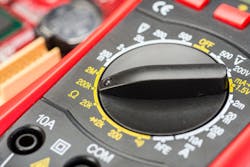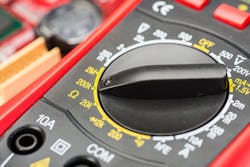Tip of the Week: Take the time to learn what your test equipment can do for you.
Does any of your test equipment have too many functions and features? Take a closer look at your most commonly used test device — probably one of your digital multimeters (DMMs). What features does it have? Which ones do you not use?
Suppose something happened to that piece of equipment, such as it got “drop tested” from the eighth flight of stairs you were climbing. Now, as you contemplate replacing that equipment, and it had features you didn’t use, does that mean you’re better off replacing it with something simpler (and probably less expensive)? Perhaps.
But look more closely at those features and how they could be useful. Are those features unused because they weren’t applicable to your work, or because work procedures didn’t try to exploit those features? Did you even realize the instrument had those features?
This scenario should bring to mind some other thoughts. You’ve got that instrument with certain features you’re not using. What if you started using them? What capabilities of that instrument could make you more effective, and why?
For example, when DMMs with measurement history first came out, many electricians didn’t use that feature for the sole reason they’d never used a feature like that. They had never had a convenient way to know the highest, lowest, and average voltage on, say, a feeder circuit.
But there’s a nuisance trip problem on a feeder, and someone says, “Hey, I can record these values and get some useful information for troubleshooting this problem.” Now all the electricians in the plant want a meter with that feature or will use that (formerly unused) feature on their own meters.
Don’t wait for someone else to figure this out for you. Take the time to learn what your test equipment can do. Then think about how you can use those capabilities to streamline your work and make you more effective. It’s probably not the case that you have “too much instrument” for your needs; you simply did not realize what that instrument can do to meet your needs.
Now, about replacing that “drop-tested” unit: Don’t just replace it; look at the newer models to see what capabilities you can make good use of that your “drop-tested” unit didn’t have. And get a carry-strap for that new unit!
About the Author

Mark Lamendola
Mark is an expert in maintenance management, having racked up an impressive track record during his time working in the field. He also has extensive knowledge of, and practical expertise with, the National Electrical Code (NEC). Through his consulting business, he provides articles and training materials on electrical topics, specializing in making difficult subjects easy to understand and focusing on the practical aspects of electrical work.
Prior to starting his own business, Mark served as the Technical Editor on EC&M for six years, worked three years in nuclear maintenance, six years as a contract project engineer/project manager, three years as a systems engineer, and three years in plant maintenance management.
Mark earned an AAS degree from Rock Valley College, a BSEET from Columbia Pacific University, and an MBA from Lake Erie College. He’s also completed several related certifications over the years and even was formerly licensed as a Master Electrician. He is a Senior Member of the IEEE and past Chairman of the Kansas City Chapters of both the IEEE and the IEEE Computer Society. Mark also served as the program director for, a board member of, and webmaster of, the Midwest Chapter of the 7x24 Exchange. He has also held memberships with the following organizations: NETA, NFPA, International Association of Webmasters, and Institute of Certified Professional Managers.

